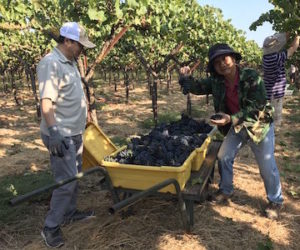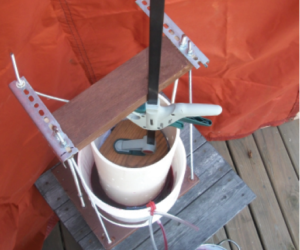Are press cuts scientific or subjective? What about combining the free run with the press runs? Do different cuts get different treatments? If you’ve ever wondered about concerns like these, take some advice from this month’s professional winemakers and gain some sense of the press.

Josh Beckett, winemaker for Peachy Canyon Winery in Paso Robles, California grew up making wine with his parents Doug and Nancy Beckett back when the winery was still called Tobias. These days, Peachy Canyon remains a success because of Josh’s upbringing as well as his focus on quality and small-scale batch production.
Free run and pressed juice have lots of different characteristics, including color, aroma, mouthfeel, tannin levels, acid balance and cleanliness. These also rely on the varietals of the grape as well as ripeness, the type of press you use and even the particular model of the press. Even the pressure and the length of time you press makes a difference. The more experimenting and trials you are willing to put forth will give you what you are trying to achieve.
The best part of keeping free run and pressed juice separate is that you end up with two wines instead of one. Your pressed juice might have some harsher tannins or be a bit astringent, but now you can blend back to your free run to the “sweet spot” where you like it. Or, maybe your free run was light in color or has a wimpy mouthfeel, but you want a few more cases out of your lot. Add back that free run until it starts to change the wine and maybe you’ll get a few extra bottles and the best wine possible for that particular lot. I would say that the only downside is the extra time and labor that separating the runs consumes. In the end, however, we all want to make the best wine possible, so it’s worth the extra effort.
Tasting is the best way to decide where to make the cuts. Any home winemaker can taste their wines as much as they like. Don’t try to create wine for the masses — you don’t have to. Make a wine that you will enjoy and are proud to share with family and friends. I have made many wines where the numbers didn’t look right and the wine probably shouldn’t have been right, but it was.
If you don’t have the space and you are afraid of squeezing the wine too much but also don’t want to leave any behind, try this setup: after your free run is gone and you start the press, keep the wine going into your free run. If you do this, you should have a setup ready to switch the wine to another storage source when you feel the wine has begun to change and don’t let the wine go into your first lot at this time. You might feel that you are pressing the wine too much. Maybe it has become a bit astringent or some harsh seed tannins are starting to dominate the palate. If you want to keep the other juice, you must stay by the press and taste throughout the press cycle. When you switch it, squeeze away and you have the first lot again. Cover it up and leave it overnight. Sometimes this wine is the best of the best — the “nectar.”
If you can, you might want to dump your pressed skins and break them up. Add them to the press again and try for another squeeze. If you really like what you got the first time, why not try for a bit more? Now you’ve got three wines from the same lot to play with.
Take your time when blending the free run and pressed juice. Let the wine settle out for a while, maybe even a few months or prior to bottling. Treat them all as separate wines and see how they age. It’s possible that you won’t like one or another at all and you’ll be thankful that you didn’t bring down the quality of the whole lot by combining the juice together at the beginning.
Continue to do small blending trials at different times. Don’t get too excited right away about a particular wine. Try the blend again a few times to make sure you like it and try to blend in the morning when you are fresh. Maybe even try blending the pressed lots together and the free run lots as well.
Who knows, but again don’t be afraid to experiment when it comes to winemaking — live on the edge!

Michael Beaulac, Winemaker and Vice President of St. Supéry Vineyards and Winery in Rutherford, California developed an interest in wine while working in the restaurant industry in Portland, Maine. In 1989 Michael moved to California’s north coast to pursue winemaking and worked for Laurier, Murphy Goode and Markham before joining St. Supéry in November 2001 as the leader of the winemaking team.
There are lots of pros and cons when it comes to separating press runs, especially on a large, commercial scale. The biggest downfall is simply logistics. Separating runs creates another lot of wine that now has to be tracked and followed. It also means that there is one more lot to taste each month — and when I have 150–175 different lots, it adds up fast! If you’re making small quantities of wine at home, this won’t be as much of a concern, but it is something to keep in mind if you make bigger or more frequent batches.
There are also many positive reasons to keep the runs separate. One thing that I am always looking for is a way to add volume or mouthfeel. Press factions will sometimes be just the things to make this happen. All of our press wine goes into new StaVin® barrels with a medium-plus toast level. This helps round the wine out and gives it more depth without too great of a cost. Another reason to keep them separate is that the free run always has a lower pH and is less tannic with lots of great fruit qualities.
To make the cuts, especially for a winery of St. Supéry’s size, I often decide what to do based on the air pressure in the press. After 1.4 bar, everything is hard press. On my preferred lots, however, I will taste as well as measure pH because I feel tasting is the all-important criteria. To get the best press wine, press slowly with as little tumbling as possible. Often times it is better to accept a lower juice yield with higher quality than to get a few more gallons of bitter, pomace-tasting wine.
After the wines are finished and dry, they are racked and sulfured. I then taste all the lots at one time. I’m looking for a couple of things; are there any wines that are exceptional? Are there any lots that should be blended back into the free run? I will also often find a press wine or two that are just beautiful that I will keep separate. Later, I will be able to blend them into my reserve wines after aging for 18 months or so.







